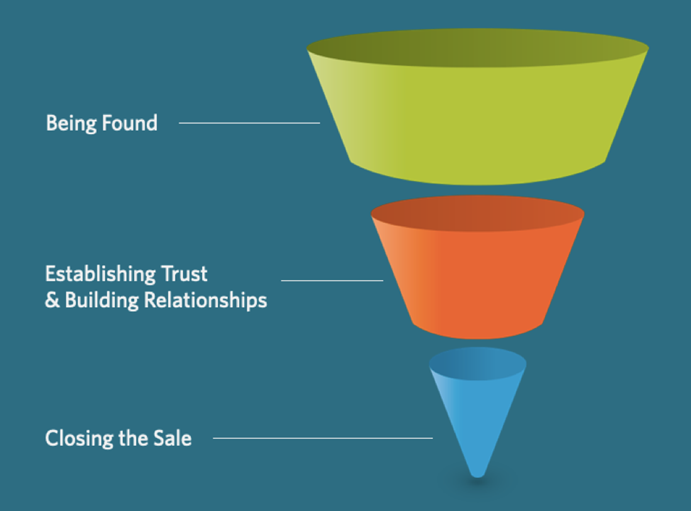What Professional Services Firms’ Websites Get Wrong
The Marketing Funnel (Part II of II)
In the August 2020 article, the author discussed five basic ways website planning and organization can result in sub-optimal results. In this article, the author drills down and looks at ways a website can fail to support a firm’s marketing funnel. The author explores the three key parts of the marketing funnel and shares where poorly designed websites come up short in each stage.

In my previous post, I discussed five basic ways website planning and organization can result in sub-optimal results. In this post, I want to drill down and look at ways a website can fail to support your firm’s marketing funnel.
You may already know that your website has a role to play at all three stages of the marketing funnel (as shown in Figure 1)—all the way from helping prospective clients find you, to delivering the educational content needed to build a loyal audience, to providing the case stories and offers that help seal the deal.
In this post, I want to explore the three key parts of the marketing funnel and where poorly designed websites come up short in each stage.

Stage One: Being Found
Mistake 1: Lack of SEO Strategy
Search engine optimization (SEO) is the art and science of helping your website be found in Google’s search engines and others. As our 2020 High Growth Study revealed, only 36% of firms reported using any kind of SEO tactics to support their marketing strategy—which creates an opportunity for you.
Mistake 2: No SEO Functional Support
SEO rules and algorithms are always evolving, so it pays to keep up with the changes and make corresponding structural adjustments to your site. If your functional support for SEO and website optimization is lacking, your website will start to fall behind.
Mistake 3: Being Mobile Un-friendly
According to Statista, in 2019 about half of all internet traffic was on a mobile device. Most websites redeveloped within the last five years use responsive design in order to be mobile friendly. Even so, one occasionally comes across older that do not. To see whether your website is mobile friendly, try taking Google’s mobile friendly test.
Mistake 4: Poor Organization of Content
Making it easy for website visitors to find the information they need plays a huge role in keeping users on your website. If your visitors are not finding what they are looking for, they will quickly leave. Every three to five years, you should thoroughly review your site’s content and do some pruning and reorganizing.
Mistake 5: Mixing Company News with Thought Leadership
One easy way to confuse visitors and dilute your expertise is mixing company announcements with your thought leadership material. It is fine to post announcements of new hires, promotions, and so on—just keep them separate from the section of your website that you are using to educate clients and prospects.
Mistake 6: Disappointing Content Quality
Quite simply, bad content will not be picked up by search engines and will also discourage visitors from returning to your website. To stand out in a crowded digital world, you need high-quality content. At Hinge, we strongly recommend leveraging the power of research to improve the quality of your content. For more on this, read our free guide, Research as Content: A Guide for B2B Marketers.
Mistake 7: Lack of Automated Filtering
To prevent visitors from getting frustrated while looking for content, give them effective search tools. If you have a large amount of blog posts or case studies, for example, filtering can create a huge boost in usability for visitors. For an example of how this works, check out how my firm’s site allows users to sort case stories based on industry.
Mistake 8: Not Tracking Visibility Metrics
For your website to increase your firm’s visibility, it is vital to track key metrics on a weekly or monthly basis. To get started, consider tracking such things as organic search traffic, total website traffic, total form fills, inbound leads, and top performing pages. For more about the top metrics to track, check out this post.
Stage Two: Building Trust and Relationships
Mistake 9: Dated Imagery or Style
The overall aesthetics of your website matters. If your site looks like those of your competition, features such tired stock images as chess pieces, fountain pens or boardrooms, or if it simply feels unsophisticated, your firm’s credibility suffers. If your website’s design is stale, consider refreshing it or building a new one.
Mistake 10: Weak Profiles of Team Members
Some firms are reluctant to feature their experts on their websites out of concern that they will be “poached” by competitors. But at Hinge, we believe that you have more to gain than lose by doing so. Remember, you want to establish trust and credibility with an audience who does not know you yet. By featuring your experts and their content, you support your claims of expertise, and add life and credibility to your website.
Mistake 11: No Cross-links between Team Members and Content
A big mistake we see is when firms create great content and expert bio pages—but then do not take the extra step of cross-linking them. Help visitors to your website draw clearer connections between your experts and the content they have written.
Mistake 12: A Disconnect between Your Site and CRM/Automation Tools
A high-performing professional services website gives visitors opportunities to connect and engage with you. Whether it is hosting webinars, posting whitepapers of interest to your audience, or similar strategies, your website should give visitors easy ways to access your expertise. When they do, that is when your marketing automation system should kick in, collecting their contact information and starting to nurture them. For more on marketing automation strategies, see this article.
Stage Three: Closing the Sale
Mistake 13: Partially Complete Case Stories
Overly brief or vague case stories are unlikely to persuade anyone. Ideally, your case stories should pop—each with its own unique message about how you solved a client’s critical problem. Videos, testimonial quotes, photos, as well as key accomplishments, results, and metrics can bring case stories to life. Each case story should have its own individual page on your website. For more, read this article with 10 tips for writing case stories.
Mistake 14: Suboptimal Landing Pages
If you are offering a free consultation, a gated piece of premium content, or access to an online event, a landing page can help you drive conversions. Many landing pages are ineffective, however, because they include either super-long forms that scare away users, distracting navigation options, or messaging that does not close the deal.
Mistake 15: Poorly Crafted Call-to-Action
Poorly designed websites typically make one of two errors: 1) not asking visitors to take the next step; or 2) having too many different asks. In the first case, a better approach is to go beyond a “Contact Us” button—for example, by offering a guide on a topic that interests your audience. In the second case, making your call-to-actions on each part of your website crystal clear produces better results. For more, see this post on making the most out of your call-to-action strategy.
Mistake 16: Inadequate Offers for Additional Engagement
Last but not least, some poorly designed websites have too few offers for further engagement—or none at all. Why not ask visitors to contact you for a free consultation, or perhaps a demo of your product in action? Professional services websites that feature specific, relevant offers outperform their peers.
Time to Demand More of Your Website
With some focused planning and strategy, you can help your website play a bigger role in engaging with prospects and closing the sale. The more you succeed at these essential functions, the more business your site will attract to your firm—every minute, every hour, and every day.
Lee W. Frederiksen, PhD, is Managing Partner at Hinge, the leading branding and marketing firm for the professional services. Hinge conducts groundbreaking research into high-growth firms and offers a complete suite of services for firms that want to become more visible and grow.
Dr. Frederiksen can be contacted at (703) 391-8870 or by e-mail to LFrederiksen@hingemarketing.com.









